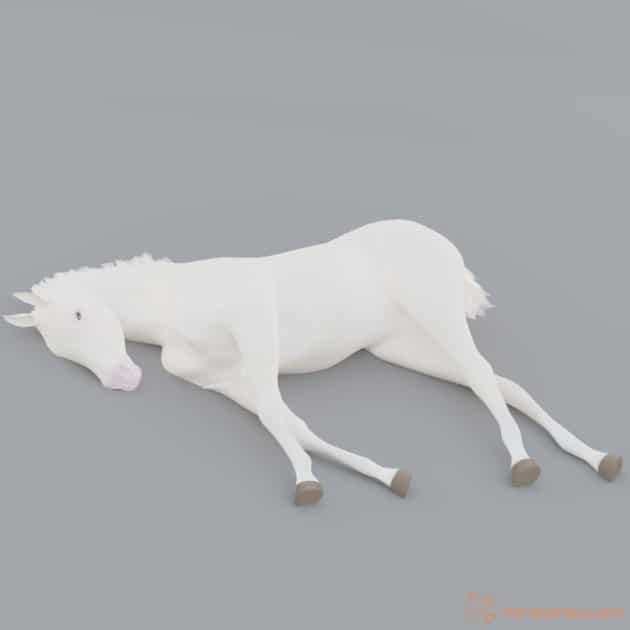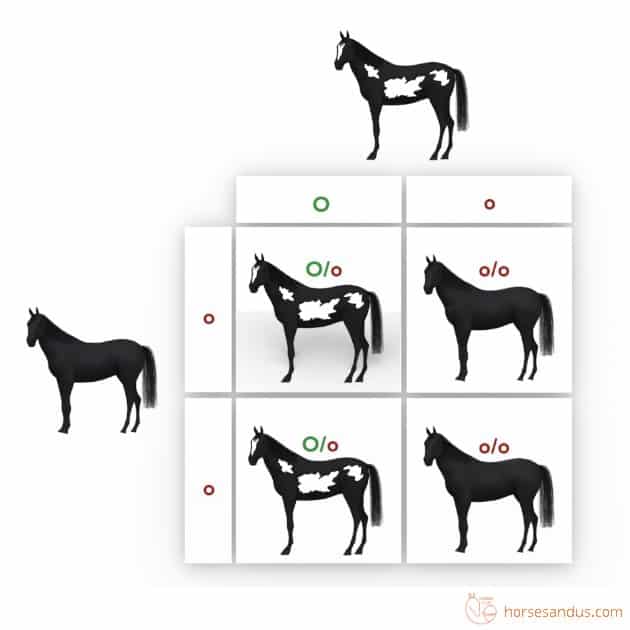You may have heard the term Overo or Frame or Frame Overo to designate horses with white patterns. But what is really behind this designation?
A Frame Overo horse can be described as having patches of white hair “framed” by areas of colored hair, thus the name “Frame.” The Frame Overo gene produces this effect. The white patches can range from minimal (almost no white) to extensive ( white covering most of the horse´s body).

There is a wide variety of horse coat colors and patterns. In this article, we will look at the patterns produced by the Frame Overo gene.
The Overo Family
Frame Overo is a pattern from the Overo Family, and sometimes it is referred to as Overo instead of the more specific Frame Overo designation.
But today, we know that there are several white patterns under the Overo group. Gradually breeders started to notice these “subpatterns” within the Overo group.
Due to recent genetic research, these separate white patterns are now clearly distinguishable and known to be caused by different genes.
These white patterns are Frame, Sabino, and Splashed White.
Characteristics of Frame Overo Horses
The following characteristics will help you identify a Frame Overo horse
- The white patches have a jagged outline and tend to be horizontally displayed on the horse’s barrel, and usually will not cross the topline. Patches can also appear in the neck and flanks as separate areas.
- The skin is pink beneath the white patches and dark beneath the colored areas.
- Usually, the four legs are colored, and most have at least one leg colored. When the legs have white markings, these are usually produced by a separate white pattern gene.
- The mane and tail are usually colored.
- The face is at least partially white and commonly has a white blaze.
- The eyes are usually brown, but one of them or both can be blue.

Frame Overo can occur with any base coat color (black, chestnut, bay) or diluted coat color (Dun, cream, silver, and champagne).

It can also exist in conjunction with other white patterns (Sabino, Tobiano, Splashed White, Leopard Complex, Dominant White, or Roan).
Frame Overo horses can also progressively whiten as they age, due to the action of the Grey gene.
How The Term Overo Evolved
In the past, the name Overo was used to describe all white patterns that were not Tobiano.
Because Tobiano was an easily recognized pattern, all others were lumped together under the name Overo.
When Overo and Tobiano patterns occurred together, the horse was named “Tovero”
Over the years, breeders started to notice certain subgroups within the Overo group.
There has also been a lot of progress in genetics research, which lead to the discovery of genes that produce these different white patterns.
We can now distinguish these different patterns and categorize them with different names: Frame Overo, Sabino, and Splashed white.
Therefore, today the name Overo also called Frame or Frame Overo, refers to a specific pattern that is produced by the EDNRB gene on chromosome 17.
Variability of the Frame Overo White Pattern
The Frame Overo white pattern has great phenotypic variability.
The extension of the white pattern can range from minimal (no white at all) to extensive (large areas of white)

Minimal Frame Overo: can have almost no white areas. In extreme cases of reduced penetrance, they can even have a total absence of white patterns but still carry the Frame Overo gene.
Medium Frame Overo: the pattern with medium expression is quite easy to identify because it will show the characteristic spotting of the Frame Overo pattern.
Extensive Frame Overo: the horse´s body is almost completely white, except for the topline and tail, where the white rarely touches.
Other Names Used For Frame Overo Horses
The white patterns of the Frame Overo are often referred to by other names.
Piebald and Skewbald
Piebald and skewbald are both terms often used to describe white patterns on a colored horse. Both these terms apply to horses carrying the frame overo gene.
Piebald is a horse with white patterns on a black base coat.
Skewbald is a horse with white patterns on a non-black coat, such as chestnut, bay, palomino, buckskin, dun, and so on. That is, on any coat color (base or diluted) other than black. A skewbald on a bay coat is also called tricolored because there are three colors: white, brown, and black.

Pinto and Paint
Both Pinto and Paint refer to horses with white patterns and any other color (black, bay, chestnut, or any dilution like, for example, palomino).
The difference is that a Pinto horse can be from any breed, whereas a Paint horse refers to a specific breed with this name.
Similarities And Coexistence With Other White Patterns
It is not always possible to visually identify if a horse is Frame Overo, especially in the following situations:
Similarities of Frame Overo With Other White Patterns
The Overo pattern is commonly confused with other white patterns such as Tobiano, Splashed White, and Sabino. However, these patterns are produced by other genes.
Coexistence of Frame Overo With Other White Patterns
The Overo pattern can also occur in conjunction with other white patterns, making it sometimes impossible to identify. For example, when Tobiano and Overo patterns are combined (Tovero), the extension of white patches is greater than that of each individual pattern because there exists an additive effect. At its most extreme, it could even result in a white horse.
Occasionally, horses carrying the Frame Overo gene do not always express the white pattern. This reduced penetrance may depend on the action of other coexisting genes.
The Genes Behind The Frame Overo

Some knowledge about the basics of horse color genetics is useful for a better understanding of this section.
The Frame Overo white pattern in horses is produced by the Frame Overo gene (EDNRB) and represented by the letter “O.”
It is an incomplete dominant allele because there is a clear difference between the heterozygous and homozygous states. We will designate the absence of this allele by “o” (little o)
Like other white pattern genes, the Frame Overo gene plays a role in distributing pigment cells across the horse’s coat.
Furthermore, all overo horses are heterozygous because they cannot survive in the homozygous state.
Breeders must know which horses carry this gene. This information can then be used when planning matings to avoid producing foals with the Lethal White Syndrome (LWS).
Frame Overo Genes Inheritance
Since Frame Overos only exist in the heterozygous state, we only need 2 Punnett squares to demonstrate the foals’ possible outcomes.
Breeds Where We Can Find The Frame Overo White Pattern
The Frame Overo pattern is most common in the American Paint horse but can also be found in other breeds.
It is frequently found in the Quarter horses, Mustang, Tennesse Walker Horses, American Saddlebred, and American Miniature Horse.
It can also be found in the Thoroughbred, although it is very rare.
Overo Lethal White Syndrome (OLWS)
Foals born with two copies of the Overo gene (homozygous) come with a lethal genetic health condition called the “Overo Lethal White Syndrome.”, which affects the digestive system.
The newly born foals show symptoms of colic because they cannot pass the feces. This is due to a lack of nerves that allow the intestine to move material through the digestive system. These foals will die within a few days.
There is no cure for Lethal White Syndrome. Since it is a painful and lethal condition, the foals are normally euthanized as soon as this syndrome is discovered.
Considering this is such a serious health condition, breeders should take special care to never breed together two horses with the Frame Overo gene.
However, horses with only one copy of this gene (heterozygous) will have a perfectly normal digestive system.
Frame Overo Pattern is Not Always Easy To Identify
It is not always easy to predict when a mating can be risky because horses will not always show visible signs of the Frame Overo spotting pattern:
- The Frame Overo pattern can be very minimally expressed, with no white spotting, a phenomenon known as reduced penetrance.
- The typical Frame Overo pattern can be masked due to interactions with other color and pattern genes.
The only way to find out is to perform a genetic test before breeding.
Commercially available genetic tests can easily detect the Frame Overo gene and therefore identify the carriers. And can also be used for diagnosing suspected cases of OLWS.
Further Reading
If you would like to learn more about horse colors and white patterns, you may want to read the following books, available on amazon.
The links below that lead to products on Amazon are affiliate links and I earn a commission (with no additional cost for you) if you make a purchase.
The following books are an introduction to horse colors and white patterns which are full of images and very easy to understand.
The Equine Tapestry: An Introduction to Colors and Patterns The Ultimate Guide to Horse ColorsA more technical book about horse colors, but still very easy to understand.
Equine Color GeneticsSources
Sources used for this article
Equine Color Genetics 4th Edition by D- Philip Sponenberg







